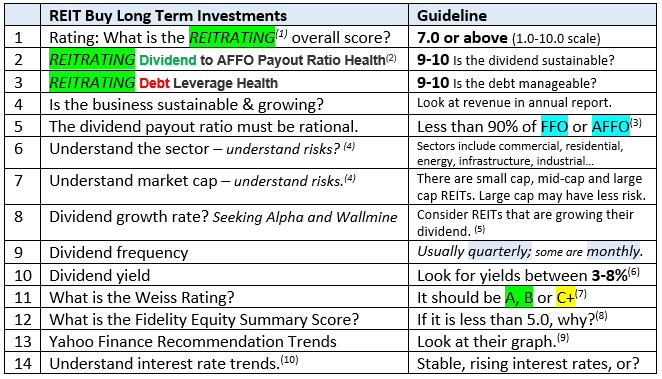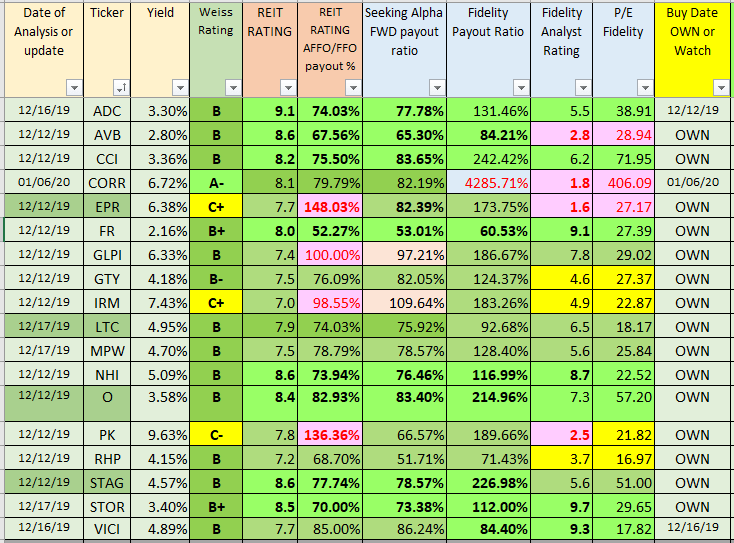Rules for REITs.
It is easy to be enticed to buy REITs for your portfolio because of high dividend yields. You could take the easy path and just buy a REIT ETF like VNQ (Vanguard Real Estate ETF.) Before you do, understand the ETF’s dividend growth trend. The following bar graph shows VNQ’s dividend history for 2015-2019. It is obvious that there is no clear dividend growth in recent years. Is there a better alternative? In my view, yes there is.

The better alternative is to buy individual REITs if you have enough cash to do so. If you have less than $5,000 your best choice may be an ETF. However, now that trading costs are $0 at many major brokerage firms, you can buy a small number of REIT shares and not pay a penalty in trading costs.
Buying a REIT investment is like buying any other stock investment. But determining which REIT to buy is not the same as buying other stock equity investments. The data you need to evaluate for buying a REIT investment is different from buying shares in a company like General Motors.
This evaluation requires a bit of work, but it shouldn’t take more than 15-20 minutes for you to find out if the investment makes sense. Let me suggest up to fourteen things to consider. However, if after you look at the first five the REIT looks questionable and risky, you should just stop. The first five use a tool called REITnotes to see dividend and debt ratings for the REIT. You will also want to know if the REIT is growing and if the dividend payout ratio makes sense for a REIT. The dividend payout ratio rules for REITs are different from most other investments. Fidelity Investments is not helpful in this regard. You should use REITnotes to see the FFO and AFFO graph for each REIT.
Is REIT “ABC” a good value to add to an investment portfolio? Based on my experience, the following factors should be examined before buying a REIT. (Notes follow.)

NOTES for the table above.
- You can get the REITRATING at REITnotes: https://www.reitnotes.com/
- FFO is Funds from Operations. AFFO is Adjusted Funds from Operations. This is different from “earnings.” Use AFFO if it is available.
- Seeking Alpha: For a quick look at the payout ratio, go to Seeking Alpha. This is an example using REIT CORR: https://seekingalpha.com/symbol/CORR/dividends/scorecard
- Look at REITnotes. If the sector is “energy”, are there unique risks based on oil prices, environmental issues or other factors? If the REIT is a small cap stock, is there enough history to show the REIT has been successful over time?
- Seeking Alpha: You can see the 5-year dividend growth rate at Seeking Alpha. But then look at the actual growth rate for the last two years on Fidelity Investments. Was the dividend increased? One that has an increasing dividend is Reality Income: https://seekingalpha.com/symbol/O/dividends/scorecard?s=o You can see a nice graph using Wallmine (CORR is the example): https://wallmine.com/nyse/corr
- If the yield is greater than 8%, make certain everything else meets the requirements. High yields are often an indication of potential trouble.
- Weiss Ratings is a subscription-based service. A rating of A+, A or A- is a strong buy. If the rating is B+, B or B- it is a buy recommendation. Any “C” rating is a HOLD. Avoid D and E investments. I pay a monthly subscription of about $25. This is a link to Weiss Ratings: https://weissratings.com/
- The Equity Summary Score (ESS) indicates the views of multiple stock analysts. A bullish rating isn’t a guarantee of success. An ESS that has a “bearish” rating indicates that, in at least the short term, it might not be wise to buy this investment. I will buy investments less than 5.0 if the other factors are favorable.
- Yahoo Finance has a nice graph that may help you see recommendation trends. This link takes you to an example for STAG: https://finance.yahoo.com/quote/STAG/analysis?p=STAG. The graph also shows the overall rating as a Strong Buy, Buy, Hold, Underperform or Sell rating. There is also an average analyst price target.
- Interest Rates: Understand what is happening with interest rates. If interest rates are low, then dividend-paying stocks become more attractive. If interest rates are high, then the price of the REIT shares could go down.
Using my rules, look at Realty Income (Ticker: O)

Another tool mentioned above is Yahoo Finance. Compare two ETFs in our portfolio: Realty Income with Stag Industrial using Yahoo Finance Recommendation Trends. Just remember that analysts are also guessing about the future. No one really knows what tomorrow may bring.

Therefore, Realty Income shares are in our portfolio because they easily meet my requirements. The next table shows the REITS currently in our portfolio. I am in the process of evaluating some to add. They are in my “watch list” which is not shown.

Remember: You don’t have to buy 100 shares. If you are uncertain that today’s price is the best price, buy 50 shares today and wait a bit to see if the price drops. Of course, if it doesn’t you may kick yourself later.


Excellent Summary and Analysis of REITs. You have also pointed out that it may be easier to invest REITS in VNQ or USRT which are the good ETFs for REITS. Isn’t it a good idea to invest REITs in a taxable account ( if someone doesn’t rely on dividend income)? or is it?. Also during a uptick or rising in interest rate environment, one should lighten up REITs positions… is that proper strategy?.
LikeLike
Thanks for the feedback. I invest in REITs primarily in the ROTH and traditional IRA. But that doesn’t mean investing in the taxable account is a bad idea. The author of this post does suggest that it is better to put REITs in a tax-sheltered account: DIVIDEND.COM
But as a counterpoint see this opinion: Seeking Alpha
I still lean towards keeping REITs in my ROTH and traditional IRA.
I don’t subscribe to the idea that you should lighten up on REITs when there is a rising interest rate, at least no initially. I like to be a buy-and-hold investor, so that causes me to evaluate each business on its merits, not on the interest rate factor. However, that isn’t to say that I would hold every REIT. Some would have to go. Others I might sell and rebuy when the price was more settled. I realize I am dancing around your question, but that is because I like to hold investments, not trade them based on sector issues.
LikeLike
This is so well written and so wonderful. Thank you so much for this! Look forward to more of your articles.
LikeLiked by 1 person
Very nice article! I enjoyed a lot Reading it. Thanks for sharing.
LikeLike
thanks for sharing … as society we move towards more co living.. co working etc ( of course post the convid scare ) in future REITs as an investment option is definately a must in the portfolio
LikeLike
Really nice and informative content with a lot of visual documentation to support it!
LikeLike